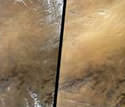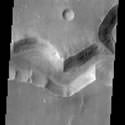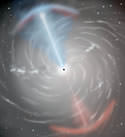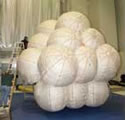
Image credit: NASA
NASA’s Terra Earth Observing Satellite was on hand this week to record some of the worst dust storms to hit China’s Inner Mongolian and Shanxi Provinces in ten years. The photo on the left shows a relatively clear day, while the one on the right is obscured by a yellowish cloud of dust. Each image was captured by the spacecraft’s Multi-angle Imaging SpectroRadiometer, and represents an area of 380 km x 630 km.
Dust covered northern China earlier this week during some of the worst dust storms to hit the region in a decade. The dust obscuring China’s Inner Mongolian and Shanxi Provinces on March 24 is compared with a relatively clear day (October 31, 2001) in these images from the Multi-angle Imaging SpectroRadiometer’s vertical-viewing (nadir) camera aboard NASA’s Terra Earth Observing Spacecraft. Each image represents an area of about 380 by 630 kilometers (236 by 391 miles).
The images are available at:
http://www.jpl.nasa.gov/images/earth/asia.
In the image from late March, shown on the right, wave patterns in the yellowish cloud liken the storm to an airborne ocean of dust. The veil of particulates obscures features on the surface north of the Yellow River (visible in the lower left). The area shown lies near the edge of the Gobi desert, a few hundred kilometers, or miles, west of Beijing. Dust originates from the desert and travels east across northern China toward the Pacific Ocean. For especially severe storms, fine particles can travel as far as North America.
The Multi-angle Imaging SpectroRadiometer, built and managed by NASA’s Jet Propulsion Laboratory, Pasadena, Calif., is one of five Earth-observing experiments aboard the Terra satellite, launched in December 1999. The instrument acquires images of Earth at nine angles simultaneously, using nine separate cameras pointed forward, downward and backward along its flight path. The change in reflection at different view angles affords the means to distinguish different types of atmospheric particles, cloud forms and land surface covers. More information is available at:
http://www-misr.jpl.nasa.gov.
NASA’s Earth Science Enterprise is a long-term research and technology program designed to examine Earth’s land, oceans, atmosphere, ice and life as a total integrated system.
JPL is a division of the California Institute of Technology in Pasadena.
Original Source: NASA News Release



